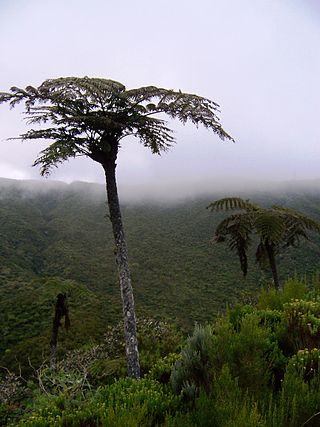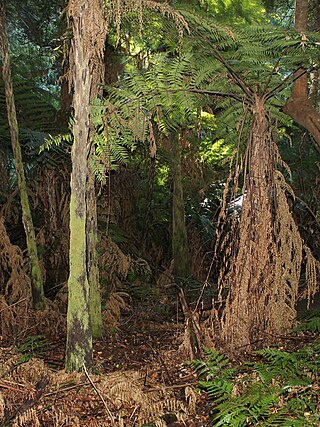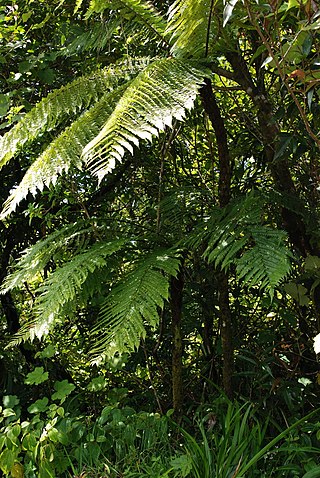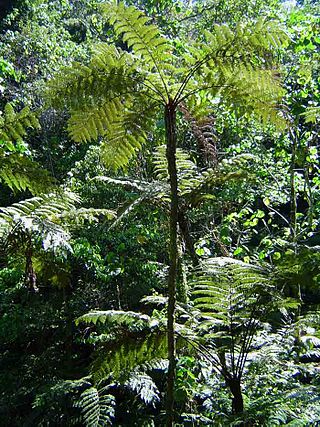
Sphaeropteris cooperi, synonym Cyathea cooperi, also known as lacy tree fern, scaly tree fern, or Cooper's tree fern, is a tree fern native to Australia, in New South Wales and Queensland.
Alsophila albidosquamata, synonyms Cyathea albidosquamata and Sphaeropteris albidosquamata, is a species of tree fern native to the Maluku Islands, New Guinea and the Bismarck Archipelago, where it grows in rain forest and montane forest at an altitude of 620–2,500 metres (2,000–8,200 ft). The trunk is erect and about 2 m tall. Fronds are bi- or tripinnate and 1–1.5 m in length. The lower surface of the rachis is covered in scales and the stipe has scattered scales throughout its length. These are glossy and pale, with dull, fragile edges. Sori occur near the fertile pinnule midvein and have flat indusia which resemble small saucers.
Gymnosphaera andersonii, synonyms Alsophila andersonii and Cyathea andersonii, is a species of tree fern native to the eastern Himalayas of India, Bhutan, and Tibet, Myanmar, and south-central China, where it grows in moist valleys and montane forest at an elevation of 300–1200 m. The trunk is erect and 6–10 m tall. Fronds are bi- or tripinnate and 2–3 m long. The entire plant is relatively dark in appearance; the rachis is flushed with dark purple and the stipe is dark, almost to the point of being black. Dark, lanceolate scales with pale fringes are sparsely scattered along the length of the stipe. Sori occur near the midvein of fertile pinnules and lack indusia.

Alsophila australis, synonym Cyathea australis, also known as the rough tree fern, is a species of tree fern native to southeastern Queensland, New South Wales and southern Victoria in Australia, as well as Tasmania and Norfolk Island.
Gymnosphaera baileyana, synonyms Alsophila baileyana and Cyathea baileyana, also known as the wig tree fern, is a species of tree fern native to northeastern Queensland in Australia, where it grows in wet gullies and forest at an elevation of 850–1200 m. It is a rare species that is seldom found in the wild. The erect trunk is 4–5 m tall, approximately 10 cm in diameter and may be covered in stipe bases in the upper regions. C. baileyana is notable for being able to develop offshoots from the base of the trunk. Fronds are bi- or tripinnate and may be exceptionally long, up to 7 m, though they are usually around 2–3 m. The rachis and stipe are dark to darkish red, scaly and may be warty, but lack spines. Scales on the rachis and stipe are purplish brown to black and have a long hair-like apex. Characteristically of this species, the last pair of pinnae are separated from the others along the rachis and may form a clump around the trunk apex. Sori are circular and occur in one to three rows along the pinnule midvein. They lack indusia.
Gymnosphaera biformis, synonyms Alsophila biformis and Cyathea biformis, is a species of tree fern native to New Guinea and the Maluku Islands, where it grows against trees in mossy forest and rain forest at elevations of 850–2200 m. The climbing trunk is very thin, only 1–2 cm in diameter, but can reach 3 m in height. The apex of the trunk is covered in scales. Two types of fronds are produced, simple pinnate fronds, which are sterile, and bipinnate fronds, which may be fertile. The stipe is smooth, glossy and very dark, almost to the point of being black. It is covered at the base with long, very dark scales that have a pale margin. Fertile pinnules are distinctly stalked and lobed. Sori occur in four pairs per pinnule lobe and lack indusia.

Gymnosphaera capensis, synonyms Alsophila capensis and Cyathea capensis, is a regionally widespread and highly variable species of tree fern. It is indigenous to Southern Africa and South America.
Alsophila costularis, synonyms Cyathea chinensis and Sphaeropteris chinensis, is a species of tree fern native to Yunnan in China, Sikkim in India, as well as Nepal, Myanmar, Laos and Vietnam. Plants grow in forest and montane forest at an altitude of 900–1800 m. The trunk is erect and 1–2 m tall. Fronds are bipinnate and 1–2 m long. The stipe is either long and warty or has short spines towards the base as well as scattered glossy dark brown scales with fragile edges. Sori occur near the midvein of fertile pinnules and are covered by thin indusia.
Alsophila fenicis, synonym Cyathea fenicis, is a species of tree fern native to the Philippines, Taiwan, and Orchid Island, where it grows in wet forest, forest margins and on hillsides. The trunk is erect, up to 1 m tall and about 6 cm in diameter. Fronds are tripinnate and 1.5–2 m long. Characteristically of this species, the lowest pinnae are usually reduced. The stipe is spiny and ranges in colour from brown to purple-dark brown. It bears two types of scales: long dark brown scales as well as minute brown ones. Occasionally the scales are pale. Sori are round and arranged in two rows, one on either side of the pinnule midvein. They are covered by very small indusia that resemble scales in appearance.
Gymnosphaera glabra, synonyms Alsophila glabra and Cyathea glabra, is a species of tree fern native to Borneo, western Java, Sumatra, the Lesser Sunda Islands, Sulawesi, and the Malay Peninsula, where it grows in lowland swamp forest and montane forest at an elevation of up to 1500 m. The trunk of this plant is erect and 2–4 m tall. Fronds are bi- or tripinnate and 1–2 m in length. Characteristically of this species, the lowest pinnae may be significantly reduced. The stipe is very dark and bears basal scales. These scales are dark, glossy and have a paler margin and fragile edges. Sori are produced in groups of one to three on fertile pinnule veins. They lack indusia.
Alsophila gleichenioides, synonym Cyathea gleichenioides, is a species of tree fern endemic to New Guinea, where it grows in open peaty grassland and on forest margins, often in groups, at an altitude of 2800–3700 m. The trunk of this plant is erect, up to 3 m tall and about 24 cm in diameter. The narrow fronds are tripinnate and about 1 m in length. Around 60 fronds form a rounded crown. The stipe is warty and bears scattered scales towards the base. These scales may be either glossy brown with a paler dull margin, or small, pale and fringed. Sori occur one or two per fertile pinnule and are protected by firm, brown indusia.
Gymnosphaera denticulata, synonyms Alsophila acaulis, Alsophila denticulata and Cyathea hancockii, is a species of tree fern native to Japan, the Ryukyu Islands, Taiwan, southern China, Hong Kong, and Hainan. It grows in forest, on stream banks, and in forest margins at an elevation of about 600 m or higher. The specific epithet hancockii commemorates William Hancock (1847-1914), who collected numerous plants in Japan, China and Southeast Asia.
Gymnosphaera henryi, synonyms Alsophila henryi and Cyathea henryi, is a species of tree fern native to eastern India and the Himalayas, Indochina, and southern China, where it grows submontane and montane forest at an elevation of 600–1200 m. The trunk of this plant is erect and may be 5–7 m tall or more. Fronds are bi- or tripinnate and usually 2–3 m in length. The rachis is smooth and dark, but occasionally has a few scattered scales. The stipe also has these scales. The scales are either small and pale with irregular fringed edges, or large and dark with a paler margin. Sori are borne on minor veins and lack indusia.
Gymnosphaera metteniana, synonyms Alsophila metteniana and Cyathea metteniana, is a species of tree fern native to the Ryukyu Islands, Japan, Taiwan, and southern China, where it grows in wet forest, forest margins, and on hillsides. The trunk of this plant is erect, up to 1 m tall, and 6–10 cm in diameter. G. metteniana has tripinnate fronds that are 1–2.5 m long. The stipe is brown to purple-black in colouration. It is covered in long, broad-based scales that are usually bicoloured. Sori are round, lack indusia, and occur in two rows, one on either side of the pinnule midvein.

Alsophila is a genus of tree ferns in the family Cyatheaceae. It has also been considered to be a section in the subgenus Cyathea of the genus Cyathea.

Alsophila glaucifolia, synonym Cyathea glauca, is a species of tree fern endemic to Réunion. Little is known about this species.
Alsophila macgregorii, synonym Cyathea macgregorii, is a species of tree fern in the family Cyatheaceae. Its trunk is approximately 3 meters tall and about 24 centimeters thick. It has narrow and tripinnate fronds which are about 1 meter long, occurring in clusters of approximately 60, and form a round crown. The stipe is scaly and warty, scales being either smooth and shiny brown or small and pale. The sori are in groups of four to six in pinnule lobes. They are covered in brown indusia. It bears similarity to Alsophila imbricata and even greater similarity to Alsophila gleichenioides. It is possible that these variations are only due to differences in habitat and they may be same species.

Sphaeropteris australis, synonyms Alsophila leichhardtiana and Cyathea leichhardtiana, the prickly tree fern, is a plant in the tree fern family, Cyatheaceae. It is native to eastern Australia. It is a common species found in moist situations, in and near rainforests.

Alsophila borbonica, synonym Cyathea borbonica, is a tree fern endemic to Mauritius and Réunion. There are several natural forms and varieties.

Alsophila manniana, synonym Cyathea manniana, the spiny tree fern or sheshino, is a species of tree fern. It is readily identified by the fierce spines on its trunk, and is widespread in the tropical regions of Africa.












